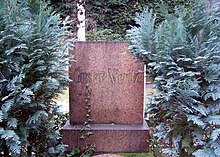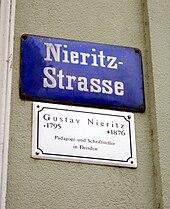Karl Gustav Nieritz
Karl Gustav Nieritz (born July 2, 1795 in Dresden ; † February 16, 1876 there ) was a German folk and youth writer.
Life
Gustav Nieritz grew up in a middle-class family. His father Carl Gottlieb Nieritz (1764–1828) was director and senior teacher of a school for the poor in Dresden-Neustadt, his mother Johanna Rahel geb. Böttcher (1772–1848) daughter of the Dresden white baker Johann David Böttcher (1719–1802). The secret government councilor, professor and director Eduard Theodor Böttcher (1829-1893) was a second cousin of Nieritz.
Determined by his parents at an early age and contrary to his own inclinations for the career and succession of his father, Gustav Nieritz initially attended his school, from 1808 to 1811 the Kreuzschule grammar school and then the seminar in Dresden- Friedrichstadt , where he took his exams early in 1814. Then he took the position of assistant teacher at the father's side, which he had to finance from his own salary. Despite the correspondingly poor salary, Nieritz married Eleonore born in 1823. Koenitzer (1803-1886).
After his father's death in 1828, the hoped-for move up to the post of senior teacher was initially made impossible due to religious differences with the superior authority, so that he had to improve the livelihood of his fast-growing family by giving private lessons and his first literary work. It was not until 1831 that he was promoted to senior teacher , initially at the school for the poor at Queckbrunnen . A year later he finally got his father's vacant position, although he continued to depend on additional income. After a restructuring of the school system, Nieritz became director of the district school in Dresden's Antonstadt in 1841 , at times also a poor director (volunteer welfare worker) and city councilor. In 1854 he applied for his retirement and since then has devoted himself entirely to writing.
Nieritz had eight children, only two of whom survived. He died on February 16, 1876 at the age of 80 in Dresden. His grave is in the Inner Neustädter Friedhof . A memorial commemorates him at the confluence of Nieritzstrasse and Theresienstrasse in Inner Neustadt . It was created by Gustav Adolph Kietz between 1876 and 1878 and shows the writer's marble bust on a granite column decorated with wreaths. Two putti move around the column, holding the wreaths.
Artistic creation
From around 1834 Nieritz became known as a writer through numerous stories for the people and youth. The spectrum of writings, mostly of a didactic and moral character, ranges from essays to novels . They appeared individually in calendars and other periodicals or in various compilations as youth libraries or publications, and some of them were translated into several languages. The Saxon People's Calendar , which he had published since 1842 (from 1850, the German People's Calendar ) , also met with great applause . In his stories, Nieritz idealized the (petty) bourgeoisie and propagated so-called bourgeois virtues such as diligence , fear of God and a sense of the family, while his writings contain anti-French , anti-Catholic , anti-democratic and anti-Semitic passages.
In addition, Nieritz drew all his life and tried, before the onset of his success as an author, at times in oil painting as a contribution to his livelihood, with some sales. The Dresden City Museum has a sketchbook and two oil paintings.
Aftermath
While Nieritz's narrative work has been forgotten, the autobiography (first edition in 1872) was reissued in a shortened version in 1997. This detailed description of the life, especially of the lower classes of the population in Dresden in the early 19th century, based on intensive knowledge of the milieu, forms a culturally and historically significant counterpart to the more well-known, but from different perspectives of his contemporaries Wilhelm von Kügelgen (memories of an old man's youth) and Ludwig Richter (memoirs of a German painter) .
Works (in selection)
- The bitter orange tree. 1830.
- The little miner or: honesty lasts the longest. 1834.
- The giant boot or the gamblers. Business adventure. 1834.
- Alexander Menzikoff, or: The dangers of wealth. 1834.
- Betty and Toms, or: Doctor Jenner and his discovery. 1834.
- The miracle pipe, or: the children of Hameln. A fairy tale. 1835. Digitized
- The misprint. Narrative. 1835.
- The adventure against will. A story from our eventful time. 1837.
- The young drum beater. 1838.
- The fourth commandment or the unequal brothers. 1840.
- Seppel, or the synagogue fire in Munich. 1841.
- Saxon folk calendar: for the year ... Wigand, Leipzig 1842–1877. ( Digitized edition of the University and State Library Düsseldorf )
- The desolate castle, or hard fight - beautiful victory. 1844.
- Georg Neumark and the viol, or who only lets God rule. 1844.
- Mother's Love and Brotherly Loyalty or The Dangers of a Big City. 1844.
- The beach right. 1845.
- The blacksmith from Ruhla. A tale ad history of the 12th century. 1845.
- The little Eskimo and the trumpet, or: who is my neighbor? 1845.
- Gustav Wasa or King and Farmer. A story from the first half of the 16th century. 1846.
- The hobby-horses or the reward of betrayal. A story based on historical facts. 1846.
- Three mothers to one child. 1846.
- The grandmother. 1847. Digitized
- The Battle of the Huns. A historical tale from the tenth century. 1847.
- The bears of Augustusburg. A story from the Saxon history of the 18th century. 1847. ( digitized version )
- A free soul or adolescent wanderings. 1849.
- The Quaker. 1849.
- Pompeii's last days. 1850.
- The judge or angry and do not sin. 1850.
- The Königstein or The New Job. 1850.
- The neighbours. 1851.
- Jacob and His Sons or The Power of Conscience. 1851
- Do not lead us into temptation or Who makes the world a valley of woes? 1851.
- Deliver us from evil. 1851.
- The outcast. A story from the 14th century. 1851.
- Traugott and Hannchen. 1852.
- Störsteffen and his son or pride and love. 1852.
- The prince robbery. 1852.
- How I came to be a writer. 1857.
- Potemkin or lord and serf. A story from the 18th century. 1859.
- Eloha or The Sheep of the Poor. 1859.
- The unfortunate days of the city of Leyden. Historical narrative from the 16th century. 1860.
- The king and the miller. A historical tale from the second half of the 18th century. 1860.
- The Powder Conspiracy or The Brothers. A historical narrative. 1860.
- William Tell. A historical tale from the 14th century. 1861.
- The source of happiness. 1861.
- The gold cook. Or: the invention of porcelain. 1853.
- Autobiography. 1872. ( digitized version )
swell
- Gustav Nieritz: autobiography . Edited by Günter Jäckel. Hellerau-Verlag, Dresden 1997, ISBN 3-910184-42-1 (abbreviated, with editor's afterword and notes)
- Günter Jäckel: Document and parable: The application of the Dresden poor school teacher Carl Gustav Nieritz (1795–1876). In: Communications of the Landesverein Sächsischer Heimatschutz eV, issue 1/1995, Dober printing and publishing house, Mügeln 1995, ISSN 0941-1151
- Fritz Alfred Zimmer: Gustav Nieritz and Karl May. In: Landesverein Sächsischer Heimatschutz (Ed.): Communications. Volume XXVI, Issue 5 to 8, Dresden 1937.
Individual evidence
- ↑ Family tree of the Böttcher family, Carl Julius Böttcher, 1886, online pdf of the SLUB Dresden
- ^ Art in public space . Information brochure of the state capital Dresden, December 1996.
literature
- Franz Schnorr von Carolsfeld: Nieritz, Karl Gustav . In: Allgemeine Deutsche Biographie (ADB). Volume 23, Duncker & Humblot, Leipzig 1886, p. 688 f.
- Gustav Nieritz: autobiography . Verlag von Georg Wigand, Leipzig 1872. ( Scan from www.archive.org, PDF, approx. 27 MB)
Web links
- Literature by and about Karl Gustav Nieritz in the catalog of the German National Library
- Works by and about Karl Gustav Nieritz in the German Digital Library
- Karl Gustav Nieritz in the Stadtwiki Dresden
| personal data | |
|---|---|
| SURNAME | Nieritz, Karl Gustav |
| BRIEF DESCRIPTION | German folk and youth writer |
| DATE OF BIRTH | July 2, 1795 |
| PLACE OF BIRTH | Dresden |
| DATE OF DEATH | February 16, 1876 |
| Place of death | Dresden |




